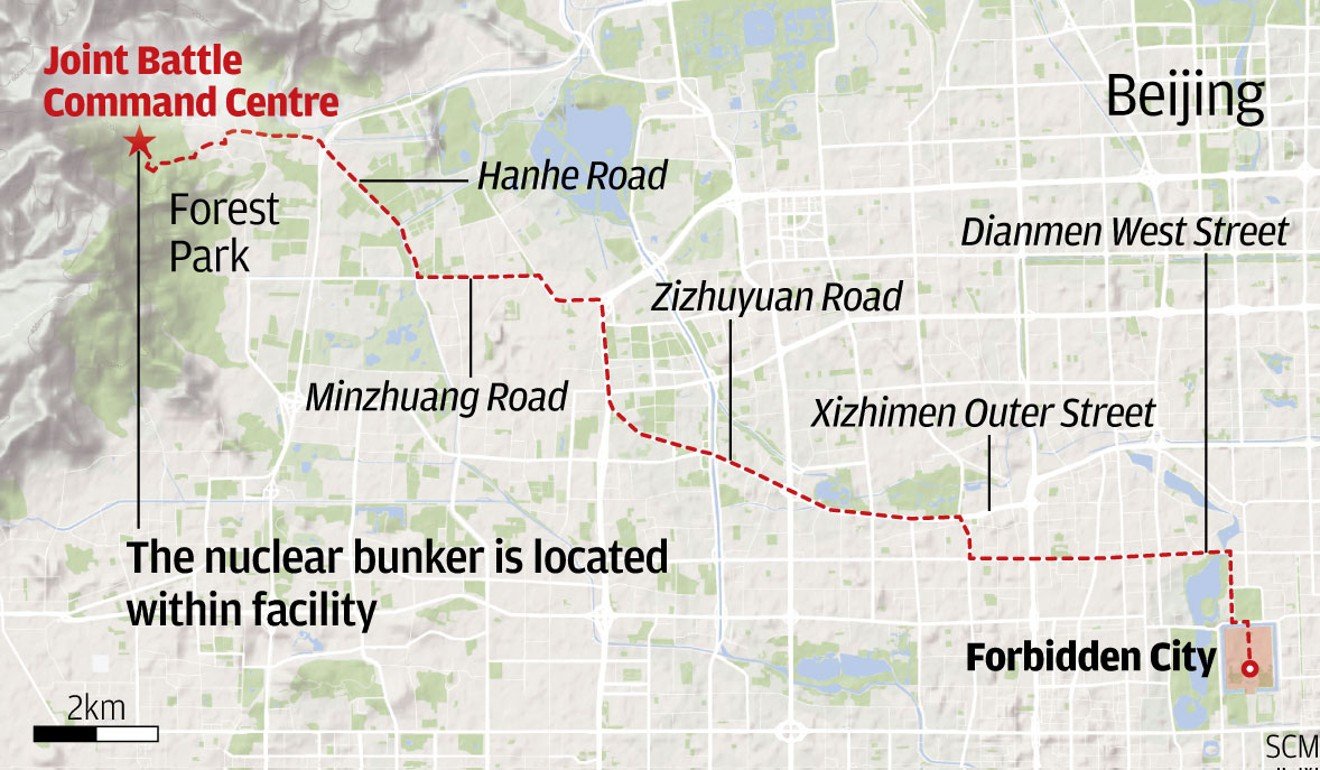| 發表文章 | 發起投票 |
一旦核戰爆發,習近平就躲這裡
Where China’s top leaders will hide to survive nuclear fallout
http://www.scmp.com/news/china/society/article/2127059/beijings-nuclear-bunker-located-worlds-most-deeply-buried-karst
Scientists shed light on Beijing’s nuclear bunker located in ‘world’s most deeply buried karst caves’
A nuclear bunker for China’s top leadership, their subordinates, troops and staff is built within the world’s most deeply buried limestone karst caves that extend more than 2km underground, beneath an unusually thick, hard layer of rock, a geological survey has found.
Located under a national park about 20km northwest of the central government’s headquarters in downtown Beijing, the fallout shelter is situated amid a network of caves that has space for a small city and a stable supply of drinking water for a million people, according to the government-funded study.
The bunker is part of the Central Military Commission’s Joint Battle Command Centre, which was revealed to the world in 2016 when state media reported that President Xi Jinping, dressed in fatigues, had visited the facility.
It is not known when either the command centre or the bunker was built but according to state media reports, work began on them decades ago and they have had major upgrades in recent years.

The command centre is referred to as the “brain” of the People’s Liberation Army because it is where all military decisions are made. Its daily operations include analysing military intelligence, monitoring activities across China’s five “battle zones” and issuing orders to military operations at home and abroad, according to state media reports.
The main entrance to the facility is located in the Western Hills National Forest Park – so in the event of a serious threat such as a nuclear strike, China’s top leaders would not have far to go from their Zhongnanhai headquarters near the Forbidden City, and the government could continue functioning from the bunker.
------------------------------(中文大約意思)------------------------------------------------
本文譯自香港《南華早報》1月7日的報導。地質調查發現一座為中國最高領導層及其下屬、部隊和工作人員修建的核掩體。該掩體建在世界上埋藏最深的石灰岩溶洞之中,這些溶洞在地下超過2公里深,位於異常堅硬厚實的岩層之下。
據政府出資的一項研究介紹,這座核掩體位於北京市中心中央政府總部(中南海)西北方約20公里處的西山國家森林公園下面,處於一群岩洞之中,像一座小城市。
該地堡是中央軍委聯合作戰指揮中心的一部分,2016年中國國家媒體在報導中共國家主席習近平身著迷彩服參觀該設施時向世界披露了這座地堡。
目前尚不清楚這個指揮中心或掩體是何時建造的,但根據中國國家媒體的報導,幾十年前就已開工,近年來又做了重大升級。
該設施的正門位於西山國家森林公園,因此,如果發生核打擊等嚴重威脅,中國最高領導人從他們的總部──紫禁城附近的中南海,不用走太遠就能進入該掩體,從那裡繼續運作。
自1950年代以來,據信在中國各地修建了幾個這樣的避難所,但它們的確切位置是機密。
這些世界末日避難所通常建在硬岩山下面,可以抵住強烈的爆炸。它們被設計成能長期獨立使用,無需外部供應,並具有先進的通風系統,以過濾掉原子彈產生的放射性污染物。
一些避難所可以像小城市那樣龐大、複雜,具有先進的通信系統,隧道寬度足以走飛機和坦克,空間可以容納1000多人。
根據一組研究該場址的地質學家介紹,北京西山作為該掩體場址有著獨特優勢。
中國科學院地質與地球物理研究所副研究員秦大軍說,他們發現了西山地下埋藏超過2公里深的石灰岩溶洞。這使得它們可與格魯吉亞世界上最深的洞穴──深度約為2200米的Krubera相提並論。
他說,雖然大多數石灰岩溶洞,包括Krubera,都直接暴露在地表或地表附近,但是西山的石灰岩溶洞被埋在一層厚厚的堅硬岩層下面。
石灰岩溶洞是數百萬年由水侵蝕石灰岩而形成。在西山,這些溶洞位於一層岩石之下,該岩石層包括花崗岩,這是自然界中最堅硬的材料之一,平均厚度為1000米。
雖然不知道該核掩體在西山地下有多深,核專家們說,一個地堡需要超過100米厚的岩層做緩衝,才能經受得住核打擊。
秦大軍是一項研究西山地下水資源項目的首席科研人員。他說該項目的目的是調查該指揮中心在世界末日式的場景下是否會用完水。
他說,北京的地下水水位自1990年代以來每年下降1米多,因為為了滿足北京蓬勃發展的人口的需求,井水被過度抽取。
據信一些地下水儲量的補給極少(指水自地表往下流的過程)。他說:「我們認為這些儲量正在枯竭,打開越多的水籠頭,剩下的水就越少。」
但研究結果表明,水危機的風險比以前想像的要低。
從西山眾多水井採集的樣本中發現的微量元素成分分析表明,該地區90%的地下水相對較新鮮,來自地表,意味著雨水、雪、河流和湖泊正在補給水。
該研究還確定了三個主要的地下水源補給源,以及幾條允許水積聚的斷層線。
秦大軍說,目前這個地區的儲量可以滿足一百多萬人的用水需求。
但湖南衡陽南華大學的核科學家劉永表示,如果發生核襲擊,致命的輻射性沉降物存留在水和土壤中的時間比在空氣中長得多。放射性粒子可能會進入地下湖泊或河流,這意味著這些水在可以使用之前需進行處理,他說。
劉永是中國軍事和核工業放射性廢物處理一個研究項目的負責人。他說:「中國已經開發出用於此目的的尖端技術和設備,是世界上最好的之列。」
一種方法是用細膜來過濾污染物,劉永說。然後將該膜浸入熔融玻璃中以遏制輻射,冷卻,密封在水泥中,儲存在特殊容器裡。
他說:「可以把它們儲存在地洞裡很多年,而不會造成任何傷害。」
原文 Where China's top leaders will hide to survive nuclear fallout
http://www.scmp.com/news/china/society/article/2127059/beijings-nuclear-bunker-located-worlds-most-deeply-buried-karst
Scientists shed light on Beijing’s nuclear bunker located in ‘world’s most deeply buried karst caves’
A nuclear bunker for China’s top leadership, their subordinates, troops and staff is built within the world’s most deeply buried limestone karst caves that extend more than 2km underground, beneath an unusually thick, hard layer of rock, a geological survey has found.
Located under a national park about 20km northwest of the central government’s headquarters in downtown Beijing, the fallout shelter is situated amid a network of caves that has space for a small city and a stable supply of drinking water for a million people, according to the government-funded study.
The bunker is part of the Central Military Commission’s Joint Battle Command Centre, which was revealed to the world in 2016 when state media reported that President Xi Jinping, dressed in fatigues, had visited the facility.
It is not known when either the command centre or the bunker was built but according to state media reports, work began on them decades ago and they have had major upgrades in recent years.

The command centre is referred to as the “brain” of the People’s Liberation Army because it is where all military decisions are made. Its daily operations include analysing military intelligence, monitoring activities across China’s five “battle zones” and issuing orders to military operations at home and abroad, according to state media reports.
The main entrance to the facility is located in the Western Hills National Forest Park – so in the event of a serious threat such as a nuclear strike, China’s top leaders would not have far to go from their Zhongnanhai headquarters near the Forbidden City, and the government could continue functioning from the bunker.
------------------------------(中文大約意思)------------------------------------------------
本文譯自香港《南華早報》1月7日的報導。地質調查發現一座為中國最高領導層及其下屬、部隊和工作人員修建的核掩體。該掩體建在世界上埋藏最深的石灰岩溶洞之中,這些溶洞在地下超過2公里深,位於異常堅硬厚實的岩層之下。
據政府出資的一項研究介紹,這座核掩體位於北京市中心中央政府總部(中南海)西北方約20公里處的西山國家森林公園下面,處於一群岩洞之中,像一座小城市。
該地堡是中央軍委聯合作戰指揮中心的一部分,2016年中國國家媒體在報導中共國家主席習近平身著迷彩服參觀該設施時向世界披露了這座地堡。
目前尚不清楚這個指揮中心或掩體是何時建造的,但根據中國國家媒體的報導,幾十年前就已開工,近年來又做了重大升級。
該設施的正門位於西山國家森林公園,因此,如果發生核打擊等嚴重威脅,中國最高領導人從他們的總部──紫禁城附近的中南海,不用走太遠就能進入該掩體,從那裡繼續運作。
自1950年代以來,據信在中國各地修建了幾個這樣的避難所,但它們的確切位置是機密。
這些世界末日避難所通常建在硬岩山下面,可以抵住強烈的爆炸。它們被設計成能長期獨立使用,無需外部供應,並具有先進的通風系統,以過濾掉原子彈產生的放射性污染物。
一些避難所可以像小城市那樣龐大、複雜,具有先進的通信系統,隧道寬度足以走飛機和坦克,空間可以容納1000多人。
根據一組研究該場址的地質學家介紹,北京西山作為該掩體場址有著獨特優勢。
中國科學院地質與地球物理研究所副研究員秦大軍說,他們發現了西山地下埋藏超過2公里深的石灰岩溶洞。這使得它們可與格魯吉亞世界上最深的洞穴──深度約為2200米的Krubera相提並論。
他說,雖然大多數石灰岩溶洞,包括Krubera,都直接暴露在地表或地表附近,但是西山的石灰岩溶洞被埋在一層厚厚的堅硬岩層下面。
石灰岩溶洞是數百萬年由水侵蝕石灰岩而形成。在西山,這些溶洞位於一層岩石之下,該岩石層包括花崗岩,這是自然界中最堅硬的材料之一,平均厚度為1000米。
雖然不知道該核掩體在西山地下有多深,核專家們說,一個地堡需要超過100米厚的岩層做緩衝,才能經受得住核打擊。
秦大軍是一項研究西山地下水資源項目的首席科研人員。他說該項目的目的是調查該指揮中心在世界末日式的場景下是否會用完水。
他說,北京的地下水水位自1990年代以來每年下降1米多,因為為了滿足北京蓬勃發展的人口的需求,井水被過度抽取。
據信一些地下水儲量的補給極少(指水自地表往下流的過程)。他說:「我們認為這些儲量正在枯竭,打開越多的水籠頭,剩下的水就越少。」
但研究結果表明,水危機的風險比以前想像的要低。
從西山眾多水井採集的樣本中發現的微量元素成分分析表明,該地區90%的地下水相對較新鮮,來自地表,意味著雨水、雪、河流和湖泊正在補給水。
該研究還確定了三個主要的地下水源補給源,以及幾條允許水積聚的斷層線。
秦大軍說,目前這個地區的儲量可以滿足一百多萬人的用水需求。
但湖南衡陽南華大學的核科學家劉永表示,如果發生核襲擊,致命的輻射性沉降物存留在水和土壤中的時間比在空氣中長得多。放射性粒子可能會進入地下湖泊或河流,這意味著這些水在可以使用之前需進行處理,他說。
劉永是中國軍事和核工業放射性廢物處理一個研究項目的負責人。他說:「中國已經開發出用於此目的的尖端技術和設備,是世界上最好的之列。」
一種方法是用細膜來過濾污染物,劉永說。然後將該膜浸入熔融玻璃中以遏制輻射,冷卻,密封在水泥中,儲存在特殊容器裡。
他說:「可以把它們儲存在地洞裡很多年,而不會造成任何傷害。」
原文 Where China's top leaders will hide to survive nuclear fallout
本貼文共有 0 個回覆
此貼文已鎖,將不接受回覆
| 發表文章 | 發起投票 |

